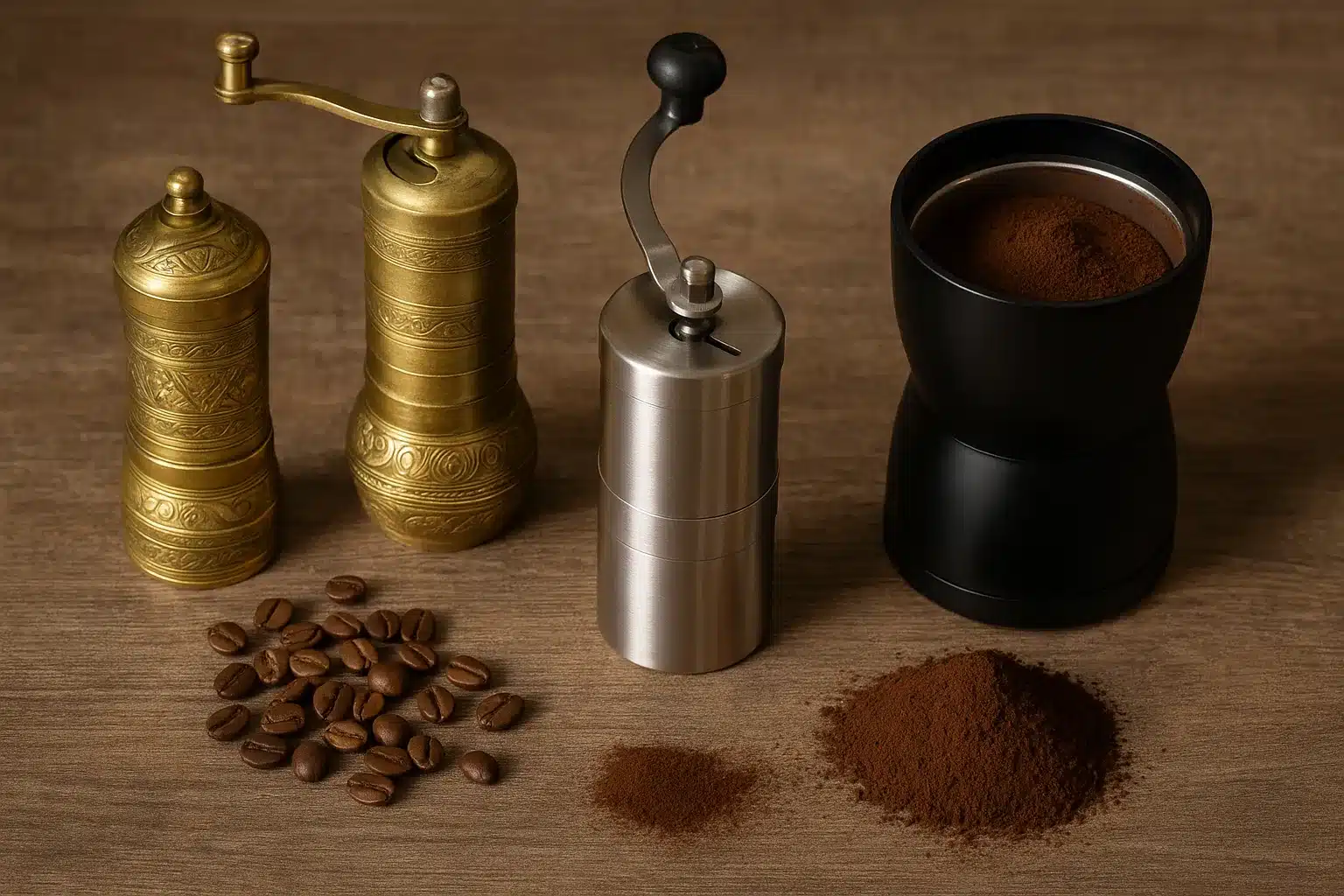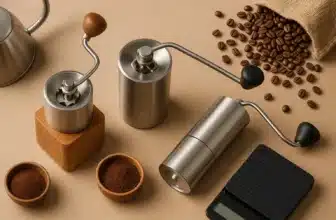
OneHundredCoffee is reader-supported, and some products displayed may earn us an affiliate commission. Details
Turkish coffee is a beautiful paradox: rustic in preparation, yet ruthlessly demanding about grind quality. To brew a proper cezve/ibrik, you need ultra-fine grounds—closer to baking flour than espresso powder—with a smooth, silky uniformity that dissolves into the cup and leaves a delicate sediment. Most general-purpose coffee grinders simply aren’t designed to go that fine with consistency, which is why choosing the right grinder matters more for Turkish than for almost any other brew method.
Best Coffee Grinders for Turkish Coffee Grinding at A Glance
| Image | Product | Features | Price |
|---|---|---|---|
Best Commercial Drip Grinder  |
| Price on Amazon | |
Best Budget Burr Grinder  |
| Price on Amazon | |
Best Budget Manual Grinder  |
| Price on Amazon | |
Quietest Blade Grinder  |
| Price on Amazon | |
Best Budget Burr Grinder  |
| Price on Amazon |
In this guide, we dig into five accessible grinders—spanning commercial workhorse, home electric burrs, and a proven manual option—to see how they handle Turkish fineness, daily usability, noise, retention, and maintenance. You’ll get a big-picture overview, then “Here’s our detailed review” sections for each product, a quick comparison table, and a practical customer guide that explains exactly what to look for if Turkish coffee is your main brew. We wrap with a personal verdict so you can pick with confidence.
Quick Comparison Table (At a Glance)
| Model | Grinder Type | Turkish Capability | Adjustability | Noise | Footprint | Price Tier | Best For |
|---|---|---|---|---|---|---|---|
| BUNN LPG Low Profile Portion Control (1 Hopper) | Commercial burr (electric) | Good with caveats (very fine possible, true Turkish may require careful calibration) | Portion/time dosing with internal range | Moderate | Large | Pro | Café or high-volume home users wanting speed & durability |
| Bodum Bistro Electric Conical Burr | Conical burr (electric) | Borderline (near-espresso fine; may be “Turkish-ish” with sifting) | Stepped | Moderate | Compact | Budget/Mid | Beginners wanting multi-use convenience |
| JavaPresse Manual Stainless Steel | Ceramic conical burr (manual) | Strong (can reach ultra-fine; patience required) | Stepped micro-clicks | Quiet | Very compact | Budget | Travelers & purists grinding one cezve at a time |
| Proctor Silex Sound Shield Electric | Blade with sound enclosure | Possible but inconsistent (powdery fines + boulders) | Pulse control | Quiet | Compact | Budget | Absolute quiet & lowest cost; not for sticklers on uniformity |
| Chefman Conical Burr Coffee Grinder (Electric Burr) | Conical burr (electric) | Borderline-to-usable (some units can be dialed fine enough) | Stepped | Moderate | Compact | Budget | Entry-level burr users, daily multi-method brewing |
Reading tip: If Turkish is 90–100% of your routine and you prize authenticity, favor a grinder that clearly hits ultra-fine (the JavaPresse manual does) or a commercial-grade grinder that can be tuned and holds calibration (BUNN LPG with careful setup). If you brew Turkish occasionally and also drink drip or pour-over, an electric conical burr (Bodum or Chefman) offers convenience with a “close enough” Turkish grind—especially if you use a sieve to remove larger particles.
Why Turkish Coffee Demands a Special Grind
Turkish coffee thrives on three things:
- Particle size: Ultra-fine, talc-like powder to extract fast in near-boiling water without filtration.
- Uniformity: A narrower spread means a richer body without harshness. Big boulders under-extract; excessive fines can over-extract bitter compounds.
- Repeatability: Turkish coffee is simple to brew; the grind is the variable that makes or breaks the cup.
Features that help: tightly aligned burrs, stable axles, micro-adjustment, low retention (so your setting stays true), and enough torque to mill fine without stalling. With that context, let’s dive into the product reviews.
BUNN LPG Low Profile Portion Control Grinder (1 Hopper)

BUNN LPG Low Profile Portion Control Grinder (1 Hopper)
Key Features
- Low-profile design fits under standard cabinets
- Portion-control dosing for consistent brew batches
- High-quality burr set tuned for drip & bulk grind
- Simple front controls; easy-clean hopper
- Commercial build quality for café or office use
Why We Like It
A reliable workhorse for drip programs: compact height, consistent dosing, and BUNN’s proven durability make it a solid pick for offices and cafés that need repeatable grinds all day.
Pros
- Consistent portion dosing
- Compact, under-cabinet profile
- Built to run long hours
- Straightforward operation & cleaning
Cons
- Not designed for espresso-fine grinding
- Industrial styling over home aesthetics
Bottom Line
A no-nonsense commercial grinder optimized for drip: stable, compact, and consistent—ideal for batch brewers and busy break rooms.
Price on AmazonCategory: Commercial electric burr • Use-case: Speed, durability, and consistency for cafés or serious home setups
Here’s our detailed review
First impressions & build:
The BUNN LPG is a compact commercial workhorse: steel body, low-profile design, and a single hopper that feeds beans into a portion-control grinding chamber. Everything screams durability and consistency—this is built to grind all day in a small café, hotel breakfast bar, or an enthusiast’s coffee nook that doubles as a lab.
Turkish fineness & uniformity:
Out of the box, the LPG is set up for a spectrum of everyday grinds (from drip through fairly fine), and it can push impressively fine when dialed in. That said, Turkish is at the end of the spectrum. With careful calibration and a willingness to experiment, the LPG can produce a powdery grind that’s very close to true Turkish, but a purist might still note a slightly wider particle spread than a dedicated Turkish mill or an espresso-focused grinder with ultra-tight tolerances. For most palates, especially when brewing with a cezve and a measured technique, cups are rich, chocolaty, and pleasantly viscous. If you want repeatably perfect Turkish with zero compromises, consider pairing the LPG with a quick sieve step—or keep a small manual Turkish grinder for ceremonial brews.
Speed & workflow:
This is where the BUNN shines. It’s remarkably fast and steady, portion-controls consistently, and shrugs off back-to-back grinds. If you entertain often or brew in batches, that throughput is addictive. For Turkish specifically, the ability to grind multiple servings in seconds is a huge plus over manual options.
Noise & retention:
It’s not whisper-quiet (few commercial grinders are), but the tone is a low, solid hum rather than a shrill whine. Retention is modest for a commercial unit—keep a small brush handy and consider single-dosing if you’re chasing absolute flavor clarity and want to minimize cross-contamination between roasts.
Cleaning & upkeep:
Accessing burrs for cleaning is straightforward if you’re comfortable with basic maintenance. A monthly deep-clean (more often if you run oily beans) keeps performance sharp and flavors transparent.
What we love
- Commercial consistency and speed
- Excellent portion-control workflow
- Solid build that stays calibrated once dialed
- Handles Turkish-adjacent fineness with confidence
Trade-offs to consider
- True, purist-grade Turkish uniformity may require careful calibration and/or sifting.
- Larger footprint and price than home-only grinders
- Louder than compact home grinders
Bottom line:
If you want speed, durability, and café-grade repeatability and you’re willing to dial in for Turkish, the BUNN LPG delivers an elevated experience with minimal fuss. It’s our “pro move” pick.
Bodum Bistro Electric Conical Burr Coffee Grinder

Bodum Bistro Electric Conical Burr Coffee Grinder
Key Features
- Stainless steel conical burrs for consistent grind size
- 12+ stepped settings from espresso to French press
- Timed grinding with simple dial for repeatable doses
- Borosilicate glass catcher to reduce static cling
- Compact footprint; silicone band for better grip
Why We Like It
An affordable entry into burr grinding that covers daily drip, pour-over, and press jobs with minimal static and an easy, repeatable timer dial.
Pros
- Consistent for drip and press
- Glass catcher reduces static mess
- Simple timed dosing
- Small, kitchen-friendly design
Cons
- Limited micro-adjustment for true espresso
- Louder than premium grinders
Bottom Line
Solid value grinder for everyday brewing with less static and easy dosing—ideal for drip, pour-over, and French press.
Price on AmazonCategory: Home electric conical burr • Use-case: Everyday convenience with occasional Turkish
Here’s our detailed review
First impressions & design:
The Bodum Bistro is a friendly, countertop-ready grinder with a compact footprint, simple stepped adjustment, and an approachable price. Its design favors user-friendliness: an easy-to-see adjustment collar, one-touch operation, and a grounds bin shaped to reduce spillage.
Turkish fineness & uniformity:
Conical burr home grinders like the Bistro are tuned for drip, pour-over, and French press, with espresso-adjacent fineness on the low end. You can push the Bistro quite fine—finer than most people expect—but its stock settings generally stop just short of classic Turkish powder. For Turkish-style cups at home, we suggest two hacks:
- Sieve pass: After grinding as fine as possible, run the grounds through a fine sieve; use the powder for Turkish and reserve larger particles for the moka pot.
- Light RDT (spritzing beans with a tiny bit of water): This can help reduce static, making Turkish-fine doses easier to handle.
With those tweaks, the Bistro can turn out enjoyable “Turkish-ish” cups—silky enough for daily enjoyment, if not competition-grade.
Daily usability:
The timer makes repeating doses easy. The stepped ring is quick to navigate when you bounce between drip, pour-over, and near-espresso. Static can be present with very fine settings, but a light RDT and letting the grinder run a second after beans clear helps.
Noise & retention:
Noise is moderate—not disruptive in a kitchen setting. Retention is typical of small home conicals; tapping and brushing clear the chute.
Cleaning & care:
Pop off the hopper, remove the upper burr, and brush. Occasional deeper cleaning keeps the fine buildup from creeping into taste.
What we love
- Budget-friendly, compact, and easy to live with
- Good all-rounder for multiple brew methods
- Gets close enough to Turkish with a sieve step
Trade-offs to consider
- Stock range doesn’t truly hit “flour-fine” Turkish
- Static management matters at the lowest settings
- Particle spread wider than the dedicated Turkish mills
Bottom line:
For a one-grinder-does-most household, the Bodum Bistro is a smart, friendly pick that can approximate Turkish when needed—especially if you’re willing to sieve.
JavaPresse Manual Stainless Steel Coffee Grinder

JavaPresse Manual Coffee Grinder (Stainless Steel)
Key Features
- Ceramic conical burrs for consistent grinding
- Up to ~18 click settings (from espresso to French press)
- Compact, lightweight, and travel-friendly
- All-metal exterior with removable hand crank
- Quiet operation—no batteries or power required
Why We Like It
A reliable, portable grinder that punches above its price—great for dialing in V60, Aeropress, and Moka, and tough enough to toss in a travel bag.
Pros
- Compact and durable stainless build
- Wide grind range with click adjustments
- Quiet and power-free
- Great value for new pour-over fans
Cons
- Small capacity (1–2 cups per grind)
- Manual effort—not ideal for big batches
Bottom Line
A tough, travel-ready hand grinder with dependable results and an approachable price—perfect as a first manual grinder or a lightweight backup.
Price on AmazonCategory: Manual ceramic conical burr • Use-case: Authentic Turkish fineness on a budget (with patience)
Here’s our detailed review
First impressions & portability:
The JavaPresse is a slim, stainless steel manual grinder that travels anywhere and takes up very little space at home. It’s simple to understand, with a click-based adjustment that holds settings reliably once you find your Turkish sweet spot.
Turkish fineness & uniformity:
Manual grinders often shine at the extremes because burr alignment is tight, and your arm is the motor. The JavaPresse can reach ultra-fine; dial all the way down and back off one or two clicks until you’re achieving a talc-like texture. Expect strong Turkish performance: silky powder, balanced cups with classic cocoa and spice notes, and that signature lingering finish. Because particle spread is tighter than most entry-level electrics at this range, cups taste clean and deeply sweet.
Speed & effort:
Grinding for one cezve (say 10–12g) takes a couple of minutes of steady turning. If your routine is a single morning cup, it’s almost meditative. For back-to-back servings, you’ll feel it in your forearm; consider splitting the work or pairing this with an electric option for guests.
Noise & retention:
It’s whisper-quiet—ideal for early mornings or shared spaces. Retention is negligible; a quick tap and you’re done.
Maintenance & longevity:
Ceramic burrs hold their edge a long time on medium-light roasts. Occasional disassembly and brushing keep everything smooth. If you grind very dark, oily beans daily, clean more frequently to maintain consistency.
What we love
- Excellent Turkish fineness and uniformity for the price
- Portable, quiet, and simple to maintain
- Repeatable click-adjustment for reliable results
Trade-offs to consider
- Manual effort and slower workflow for multiple servings
- Small capacity; suited to single-serve Turkish brews
- Not ideal if you often switch to coarse methods (lots of re-dialing)
Bottom line:
If Turkish is your ritual and you value authenticity and true ultra-fine grind on a budget, JavaPresse is an easy recommendation. It’s our value pick for purist Turkish.
Proctor Silex Sound Shield Electric Coffee Grinder (Quiet Grinding)

Proctor Silex Sound Shield Electric Coffee Grinder (80402)
Key Features
- Sound Shield” lid reduces grinding noise for early mornings
- Stainless steel blades grind coffee, spices, and seeds
- Removable grinding bowl for easy filling and cleanup
- Simple press-to-grind operation with clear lid view
- Compact footprint stores easily in small kitchens
Why We Like It
A budget-friendly grinder that keeps the volume down. The removable cup and quiet lid make quick work of morning beans without waking the whole house.
Pros
- Noticeably quieter than typical blade grinders
- Removable cup simplifies pouring and cleaning
- Multi-use: coffee, spices, nuts
- Small, affordable, easy to store
Cons
- Blade grind is less uniform than burr grinders
- Short grind times needed to avoid overheating
Bottom Line
A quiet, practical starter grinder for everyday drip or pour-over—great value if you want low noise and easy cleanup.
Price on AmazonCategory: Blade grinder with sound-dampening lid • Use-case: Maximum quiet and minimum cost
Here’s our detailed review
First impressions & design:
The Sound Shield’s calling card is right in the name: a clear, dampening lid that noticeably softens the grind noise. It’s compact, easy to stash, and simple to operate.
Turkish fineness & uniformity:
Blade grinders can generate very fine powder, but they do so by chopping rather than shearing. The result is a bimodal mess: plentiful powder and stubborn boulders. For Turkish, that inconsistency shows up as muddled flavor—over-extracted bitterness from fines with pockets of under-extraction from larger particles. You can improve results with the technique:
- Pulse-and-shake: Short pulses while gently swirling the grinder to redistribute beans.
- Sieve step: After grinding, sieve out larger bits and re-grind only the leftovers.
With patience, you’ll approach drinkable Turkish cups, especially with darker roasts that emulsify easily. But compared to burr grinders, uniformity remains the Achilles’ heel.
Noise & convenience:
The Sound Shield is one of the quietest ways to make coffee grounds—great for roommates, babies, or thin-walled apartments. Cleanup is quick, and there’s no hopper or chute to worry about.
What we love
- Extremely quiet and affordable
- Tiny footprint; super simple to use
- Can produce powdery fines quickly
Trade-offs to consider
- Inconsistent particle size; flavor clarity lags behind burr grinders
- Heat build-up possible on long runs; use short pulses
- Not ideal for those seeking classic, balanced Turkish cups
Bottom line:
If your top priorities are quiet operation and low cost, and you’re okay with “good enough” Turkish using pulse-and-sieve hacks, this can serve. Purists should look elsewhere.
Chefman Conical Burr Coffee Grinder (Electric Burr)

Chefman Conical Burr Coffee Grinder (Electric Burr)
Key Features
- Conical burrs for uniform grind and better flavor
- Multiple grind settings for espresso to French press
- One-touch operation with removable grounds container
- High-capacity hopper for batch grinding
- Easy-clean design; detachable burr components
Why We Like It
A straightforward, wallet-friendly burr grinder that delivers consistent particles across brew methods—great for upgrading from a blade grinder without overspending.
Pros
- Reliable burr consistency for better extraction
- Wide range of grind sizes for many brewers
- Simple, one-touch workflow
- Large hopper and easy cleanup
Cons
- Louder than premium grinders
- Coarse steps may limit ultra-fine tuning
Bottom Line
Solid entry-level burr grinder that boosts cup quality and consistency at a very approachable price.
Price on AmazonCategory: Home electric conical burr • Use-case: Entry-level burr performance for mixed brewing styles
Here’s our detailed review
Build & usability:
The Chefman is a compact conical burr unit with a straightforward user interface and a stepped adjustment ring. It’s designed to be a practical, daily driver for everything from French press to moka pot—and it can be coaxed toward very fine settings for espresso-adjacent use.
Turkish fineness & uniformity:
As with many budget home burrs, stock Turkish performance is borderline. You can typically get a grind that’s very fine, but just shy of that talc-like finish. Some users get better results by finding the “zero point” (where the burrs just begin to touch) and then dialing back a click—this can slightly extend the fine range and improve uniformity. With the Chefman at its absolute lowest setting and a quick sieve pass, you’ll brew respectable Turkish-style cups at home.
Workflow & consistency:
Dosing is predictable with a bit of practice. Static is manageable with a light RDT and a short post-grind run to clear the chute. Retention is modest; a few taps usually do the trick. Noise is typical for a small kitchen grinder—noticeable, but not sharp.
Maintenance:
Routine brushing and occasional deep-cleans keep fines from packing in. The burrs are easy to access, which is appreciated at this price point.
What we love
- Friendly price for a true burr grinder
- Compact and easy to operate
- Can approach Turkish with careful dialing and sifting
Trade-offs to consider
- Not a dedicated Turkish grinder; uniformity lags the manual option
- Fine range may vary unit-to-unit at the extreme low end
- Static management matters at ultra-fine settings
Bottom line:
If you want an affordable electric burr for multi-method brewing and the option to brew Turkish-style occasionally, the Chefman is a sensible, low-stress choice.
Customer Guide: How to Choose a Grinder for Turkish Coffee
1) Prioritize true ultra-fine capability
Turkish coffee needs flour-fine powder. A grinder that only reaches espresso-fine will make cups that taste close but not quite right. Manual grinders (with tight alignment) and commercial-grade machines tend to fare best; many entry-level conicals can get “near enough” with a sieve.
2) Look for tight tolerances, not just “burrs”
Burr geometry and alignment matter. Even a small wobble widens particle spread. For electric options, stable axles and solid burr carriers are your friends. For manual grinders, check for play at the handle/shaft—less is better.
3) Micro-adjustment beats broad steps
The difference between perfect and “a little bitter” Turkish can be one or two clicks. Grinders with fine, repeatable adjustment make dialing in painless.
4) Noise, speed, and volume
- Single-serve ritualists: Manual is quiet and exact.
- Households & hosting: Electric speed wins; commercial builds crush volume.
- Babies & roommates: Sound-dampened lids or manual grinders keep peace.
5) Retention & static
Fine grinds cling. Low-retention designs, short chutes, and simple paths help. A tiny spritz of water on beans (RDT) before grinding tames static and mess.
6) Budget reality check
- Lowest budget: Blade can work with technique + sieve, but expect trade-offs.
- Value purist: Manual grinder (like JavaPresse) offers genuine Turkish grind without breaking the bank.
- Convenience seeker: Entry electric burrs (Bodum, Chefman) are versatile with “Turkish-ish” results.
- No-compromise speed: Commercial-leaning grinders (BUNN) bring power and repeatability.
7) Care & cleaning
Turkish fines pack into burr teeth and chutes. Brush after each session and deep-clean monthly. Consistent maintenance = consistent cups.
Who Should Buy What? (Tight Recommendations)
- I brew Turkish every day, one cup at a time, and love the ritual.
Get: JavaPresse Manual — authentic fineness, compact, quiet, affordable. - I want a fast, robust setup for guests and a daily variety, including Turkish-style.
Get: BUNN LPG — commercial consistency and speed, with Turkish-capable fineness when calibrated. - I’m a convenience-first home user brewing drip/pour-over most days, Turkish occasionally.
Get: Bodum Bistro or Chefman Conical Burr — both deliver good daily usability and “near Turkish” with a sieve. - I need the quietest possible option at the lowest price.
Get: Proctor Silex Sound Shield — understand you’re trading away uniformity.
Personal Opinion & Final Verdict
If I had to choose one grinder for purist Turkish flavor on a budget, I’d pick the JavaPresse Manual. It reliably reaches the right texture, and the cups are deeply satisfying—sweet, dense, and unmistakably Turkish. The ritual of hand-grinding actually adds to the experience.
For a kitchen-counter do-everything electric that can serve family and friends and still produce good Turkish-style cups, I like the Bodum Bistro ever so slightly more than the Chefman for its friendly ergonomics—as long as you’re willing to sieve. The Chefman remains a smart buy if it’s the better deal when you shop.
If you want blazing speed, café-grade repeatability, and serious build quality, the BUNN LPG feels fantastic to use and can be tuned to satisfy most Turkish lovers who also appreciate its portion-control throughput.
The Proctor Silex Sound Shield earns its place as the quietest, least expensive way to experiment. With careful pulse-and-sieve technique, you’ll make enjoyable cups—but if Turkish becomes your daily ritual, upgrade to a burr.
My two-grinder dream team: JavaPresse for morning cezve perfection + Bodum Bistro (or Chefman) for everything else. It’s affordable, covers every brew style, and keeps your Turkish grind uncompromised.
Conclusion
Turkish coffee is simple to make but exacting about the grind. If your grinder can truly hit that flour-fine texture with a tight particle spread, you’re 90% of the way to syrupy, perfumed cups that feel luxurious and comforting. Among accessible options, the JavaPresse Manual is the most reliable path to authentic Turkish on a budget; the BUNN LPG brings commercial power and consistency if you want speed and volume; and the Bodum Bistro/Chefman Conical Burr duo covers convenience with passable Turkish via a sieve. The Proctor Silex Sound Shield is the quiet wildcard for curious newcomers.
Pick based on how often you brew Turkish, how many cups you make at once, and how much you value ritual versus speed. Get the grind right, and everything else about Turkish coffee—foam, aroma, sweetness—falls beautifully into place.






